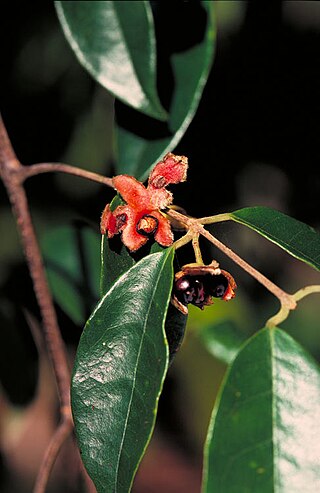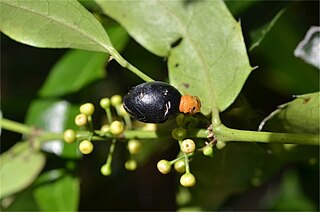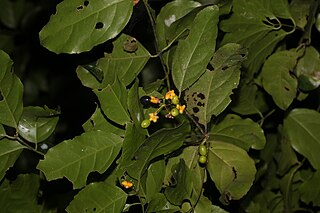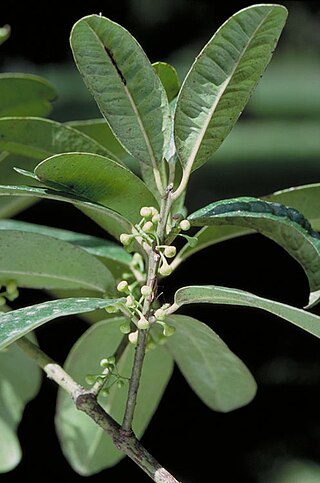
Hedycarya angustifolia, commonly known as native mulberry, Australian mulberry, or djelwuck is a species of flowering plant in the family Monimiaceae, and is endemic to eastern Australia. It is a shrub or small tree with elliptic or egg-shaped to lance-shaped leaves and male and female flowers on separate plants. Male flowers are borne in branched clusters of 5 to 16 and have 8 tepals and about 50 stamens and female flowers have about 12 tepals and 40 to 50 carpels. The fruit is a more or less spherical, tightly clustered yellow or orange drupes.

Wilkiea hugeliana, commonly known as veiny wilkiea, common wilkiea or tetra beech, is a species of flowering plant in the family Monimiaceae, and is endemic to eastern Australia. It is a tall shrub or small tree with egg-shaped, oblong to narrowly elliptic leaves, and male and female flowers on separate plants. Male flowers have 3 or 4 stamens and female flowers have 20 to 40 carpels, and the fruit is a blackish oval drupe with a yellow to orange receptacle.

Tasmannia membranea, commonly known as pepper tree, is a species of flowering plant in the family Winteraceae, and is endemic to north-eastern Queensland. It is a shrub or tree with lance-shaped or egg-shaped leaves, male and female flowers on separate plants, with two petals on each flower. The male flowers have 30 to 62 stamens, and the female flowers have a single carpel with 14 to 36 ovules, and the fruit is black.

Wilkiea is a genus of flowering plants in the family Monimiaceae, and is native to Australia and New Guinea. Plants in this genus are monoecious or sometimes dioecious trees and shrubs, the leaves with many fine oil dots, male and female flowers in cymes or panicles, and oval black drupes.

Acronychia octandra, commonly known as doughwood, silver birch or soapwood, is a species of rainforest tree that is endemic to eastern coastal areas of Australia. It has mostly trifoliate leaves with elliptic to egg-shaped leaflets, greenish-white flowers arranged in groups in leaf axils and fleshy fruit of four carpels fused at the base.

Palmeria is a genus of about 17 species of flowering plants in the family Monimiaceae mostly native to Australia and New Guinea. One species is also native to Sulawesi and the Bismarck Archipelago. Plants in the genus Palmeria are woody climbers or climbing shrubs with usually 7 to 15 flowers, the flowers either male or female.

Palmeria scandens, commonly known as anchor vine or pomegranate vine, is a species of flowering plant in the family Monimiaceae and is native to Queensland, New South Wales and New Guinea. It is a woody vine with elliptic to oblong leaves and male and female flowers borne on separate plants, male flowers usually with thirty to forty stamens and female flowers with about ten carpels. The fruit is green, splitting to form a pinkish receptacle with 3 to 7 black or red drupes.
Elaeocarpus ruminatus, commonly known as brown quandong, caloon or grey quandong, is a species of flowering plant in the family Elaeocarpaceae and is endemic to Queensland. It is a tree with buttress roots at the base of the trunk, mostly more or less elliptic leaves, cream-coloured flowers with five petals that sometimes have a divided tip, and more or less spherical fruit.

Palmeria hypotephra is a species of flowering plant in the family Monimiaceae and is endemic to Queensland. It is a woody climber with elliptic to egg-shaped leaves, male and female flowers on separate plants with 4 or 5 tepals, male flowers with 30 to 35 stamens, female flowers with 10 to 12 carpels, and spherical, dark brown to black drupes.

Wilkiea angustifolia is a species of flowering plant in the family Monimiaceae, and is endemic to Queensland. It is a dioecious shrub with elliptic leaves, male and female flowers on separate plants, male flowers with 4 stamens, female flowers with 8 to 20 carpels, and the fruit a purple to black drupe.

Palmeria foremanii, commonly known as anchor vine, is a species of flowering plant in the family Monimiaceae and is endemic to an area near the New South Wales - Queensland border. It is a tall, woody climber or scrambling shrub with usually elliptic leaves, male and female flowers on separate plants with 5 tepals, male flowers with 40 to 43 stamens, female flowers with 7 to 12 carpels, and spherical, shiny black drupes.

Wilkiea austroqueenslandica, commonly known as smooth wilkiea or furry-flowered wilkiea, is a species of flowering plant in the family Monimiaceae, and is endemic to eastern Australia. It is a spreading shrub or small tree with egg-shaped to elliptic leaves, male and female flowers on separate plants, male flowers with about 30 stamens, female flowers with about 35 carpels, and the fruit is a glossy, olive-black drupe with an orange fruiting receptacle.

Wilkiea cordata is a species of flowering plant in the family Monimiaceae, and is endemic to north-east Queensland. It is a shrub or small tree with oblong leaves, male and female flowers on separate plants, male flowers with stamens in 2 pairs, female flowers with about 25 carpels, and the fruit is an oval drupe with a yellow receptacle with an orange tinge.
Wilkiea hugeliana is a species of flowering plant in the family Monimiaceae, and is endemic to Cape York Peninsula in far northern Queensland. It is a shrub or small tree with elliptic, sometimes toothed leaves, and male and female flowers on separate plants. Male flowers usually have 4 pairs of stamens and female flowers have about 40 carpels, and the fruit is a glossy black drupe with enlarged orange receptacles.
Wilkiea kaarruana is a species of flowering plant in the family Monimiaceae, and is endemic to northern Queensland. It is a shrub or small tree with elliptic to oblong leaves, and male and female flowers on separate plants, each with 4 to 6 tepals. Male flowers usually have 2 pairs of stamens and female flowers have about 21 to 26 carpels.

Wilkiea longipes is a species of flowering plant in the family Monimiaceae, and is endemic to northern Queensland. It is a shrub or small tree with elliptic to egg-shaped leaves with the narrower end towards the base, and male and female flowers on separate plants. Male flowers usually have 3 or 4 pairs of stamens and female flowers have about 9 to 13 carpels.

Wilkiea macrophylla, commonly known as large-leaved wilkiea, is a species of flowering plant in the family Monimiaceae, and is endemic to north-eastern Australia. It is a glabrous shrub or small tree with narrowly to broadly elliptic leaves, and male and female flowers on separate plants. Male flowers have 2 pairs of tepals and usually 2 pairs of stamens, and female flowers have 6 or 7 pairs of tepals and 13 to 20 carpels. The fruit is a glossy purplish to olive black drupe.

Wilkiea pubescens is a species of flowering plant in the family Monimiaceae, and is endemic to north Queensland. It is a shrub or small tree with elliptic leaves and male and female flowers on separate plants. Male flowers have 6 tepals and 2 or 3 pairs of stamens and female flowers have 2 pairs of tepals and 15 to 30 carpels. The fruit is a purplish-black drupe.

Wilkiea rigidifolia is a species of flowering plant in the family Monimiaceae, and is native to north Queensland and New Guinea. It is a shrub or small tree with elliptic to broadly elliptic or oblong leaves and male and female flowers on separate plants. Male flowers are borne in clusters of 20 to 30 and have 4 pairs of tepals and 2 or 3 pairs of stamens and female flowers have 2 pairs of tepals and 40 to 50 carpels. The fruit is a glossy black drupe.
Wilkiea smithii is a species of flowering plant in the family Monimiaceae, and is endemic to north-eastern Queensland. It is a shrub or small, slender tree with elliptic or oblong leaves and male and female flowers on separate plants. Male flowers are borne in clusters of about 5 and have 8 tepals and 2 pairs of stamens and female flowers have 20 to 40 carpels. The fruit is a glaucous, purplish to black drupe.
















